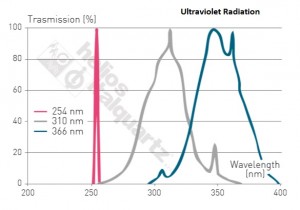
The name Wood Lamp (named after the American scientist Robert Williams Wood), or black light, refers to a light source that emits electromagnetic radiation predominantly in the range of ultraviolet and in the visible light range.
Helios produces Wood lamps with ultraviolet emissionpeaks at 254 nm, 310 nm and 366 nm:
- UV-C short-waves (180-280 nm) emitted at 254 nm are suitable for chemical, photochemical and chromatographic applications; in microbiology they are useful for the identificati
 on of bacteria and fungi, for the analysis of fluorescent materials and for the analysis of minerals.
on of bacteria and fungi, for the analysis of fluorescent materials and for the analysis of minerals. - UV-B medium waves (280-320 nm) emitted at 310 nm are suitable for the chromatographic analyses and GEL, for tests on thin layers, for searching tests of electrophoresis in DNA / RNA, and for the analysis of minerals.
- UV-A long-waves (320-380 nm) emitted at 366 nm are suitable for many organic applications, fluorescence tests, in the food processing industry, for the control of banknotes and documents, art restoration, in many microbiological tests or in the field of dermatology diseases and for the cure of favism or for geological inspections.
A Wood Lamp produces light which is not directly visible to the human eye; however, it can be used to illuminate materials on which an ultraviolet radiation causes fluorescent and phosphorescent effects. Possible applications of these properties can be found in the fight against the counterfeiting of banknotes, through the use of banknote verification, or in the search for cracks in metal structures which are coated with materials responsive to UV rays.
